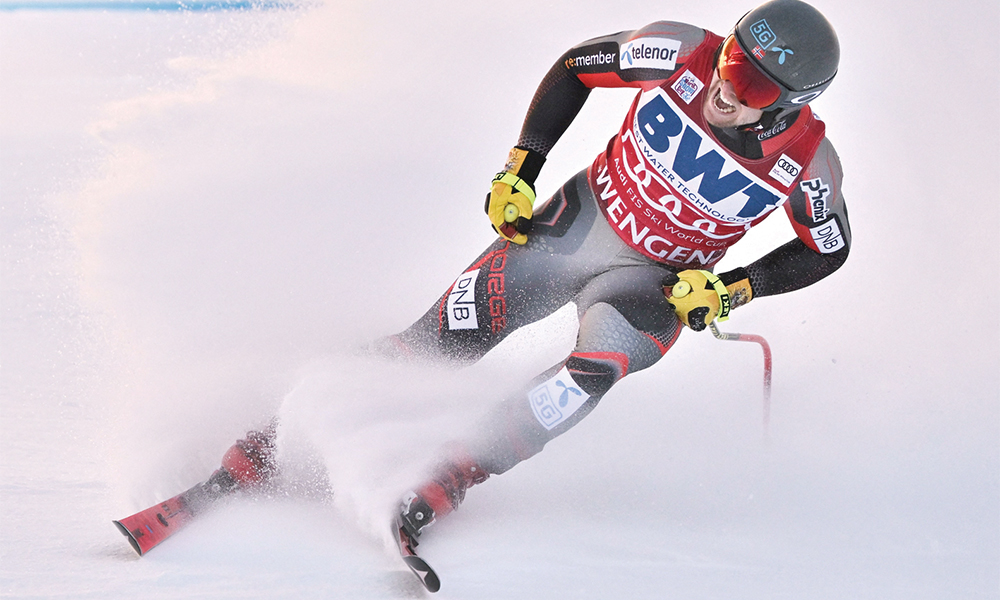KITZBUHEL, Austria: As a warm-up for the Beijing Olympics, it does not get any tougher: The men’s World Cup downhill in Kitzbuehel, the most prestigious course on the circuit, but also widely regarded as the most testing.
Just weeks out from the February 4-20 Winter Games, skiers will take to the thigh-trembling 3.3km-long Streif course on the Hahnenkamm mountain in the knowledge that nothing can be held back on a piste where the vertiginous start sees them reach 100km/h in the first five seconds.
The 82nd running of the downhill, which made its debut in 1931, will see racers reaching motorway-coasting speeds of 140km/h while negotiating sections that have an 85-percent gradient, meaning any thoughts about potential gold in Beijing are temporarily put on the back burner.
The course falls, snakes and rolls, sending competitors barrelling through a wide variety of terrain, in parts propelling them in the air, only for them to quickly re-align for icy traverses that severely test technical ability and mastery of well-honed equipment. “This slope is so difficult, I always had to dig deep to get the best out of myself,” said retired Swiss racer Didier Cuche, who holds the record of five downhill wins on the mountain named after a rooster’s comb. “I always had my back against the wall and needed to get everything right at the right moment.”
Then into play comes the so-called “risk management”: How much a racer is able to push himself, much like a Formula One driver, in the knowledge that one slight error might mean hurtling into some of the 15km of nets and fencing down the course. “On the Streif, the fine tuning has to be somewhere between 90 and 100 percent and adjusted to your own ability and what the hill allows,” argues Cuche. “You can then move within this percentage range without exceeding the risk limit because as soon as you make a mistake, the race is over, or you fall-and that hurts.”
Highlight of the season
There have been some gruesome crashes over the years. Sliding bodies, flailing skis and helicopter evacuations have become a regular feature and quickly silence the crowd. COVID-19 restrictions mean a maximum of 1,000 spectators this year, a far cry from the 90,000 Kitzbuehel normally welcomes, a heady mix between champagne-drinking gliterati and young locals revelling in an alcohol-fuelled rite of passage. Their absence from the unashamedly voyeuristic spectacle will deprive all racers of the gladiatorial baying, the meek silence after a crash and the subsequent raucous applause should the crash victim be able to refind his footing.
“May this sports festival be held in an orderly and safe manner and distract us a little from everyday worries after spending almost two years in the clutches of the pandemic,” says race committee chairman Michael Huber.
After downhill training runs until today, skiers will compete in a first downhill on Friday, before taking on a slalom tomorrow-when heavy snow is forecast, and a second downhill on Sunday. “Kitzbuehel is the highlight of the year for us downhill skiers,” Austrian Vincent Kriechmayr, who won in Wengen last week, told ORF television.
“This is simply the most difficult descent of the whole year. The Streif is also a legendary route in other respects. You can’t leave anything to chance. You have to be in top shape there. “I don’t know what’s in store for me at the Olympic Games, but Kitzbuehel is the downhill run that you want to win as an Austrian.”
Kriechmayr and his teammate Matthias Mayer are among a group of favourites for downhill victory that also includes in-form Norwegian Aleksander Aamodt Kilde, the Swiss duo of Marco Odermatt and Beat Feuz, and the Italian pairing of Christof Innerhofer and Dominik Paris. — AFP











